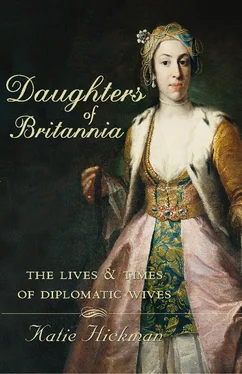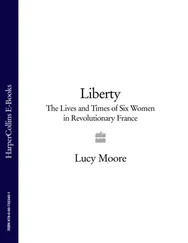1 ...7 8 9 11 12 13 ...22 In 1964 Ann Hibbert’s husband Reg was sent to Ulan Bator, the capital of Mongolia, to open the British embassy; she later flew out there on her own under very strange circumstances. It was at the height of the Cold War, and sometime in the middle of the night they came down to refuel on the Soviet – Mongolian border. Although Anne was allowed off the plane, the Russians went to some lengths to stop her from talking to the other passengers. ‘I was told that I was not to go with the others,’ she remembers. ‘I was separated from them, and taken into a room by myself and the stewardess, very kindly, said, “I have to lock you in. Would you like the key on the inside or the outside?” I said, “On the inside, if you don’t mind.” So I was locked up, while the plane was refuelled.’
Single women travelling on their own, even respectable married ones, have always been faced with special complications, as Sheila Whitney found when she went to China in 1966.
Ray said, ‘You need a rest, come out on the boat,’ which I did and it took me four and a half weeks – the slow boat to China. I didn’t particularly enjoy it because I was a woman on my own, and in 1966 if you were a woman on your own, and one man asks you to dance more than twice you were a scarlet woman. I went and sat on the Captain’s table and there was a young chap there, and he was engaged to somebody, so I said, ‘Oh well, we’re in the same boat. You’re being faithful to your fiancée, and I’m being faithful to my husband, perhaps we can, you know …’ I didn’t invite him to dance or anything. But, no, they all had to be in bed by half past ten. On the journey before they’d all been in trouble, apparently, and so they all had to be in bed by half past ten at night. All the ship’s officers. Anyway, that was that. I was sharing a cabin with a young eighteen-year-old girl, who was there with her parents, and I used to go out with her parents, because if I did anything else I was labelled. It was ghastly. I can’t tell you how ghastly it was. But it was very funny, too. So I didn’t have such a gay time as I thought I was going to have. You know, I was looking forward to it.
At the turn of the century a similar regard for propriety governed long sea voyages, although, if Lady Susan Townley is to be believed, the rules were slightly less strict then than they were in the 1960s. * On her journey to Peking from Rome in 1900 she noted the popularity of parlour games, especially musical chairs, during which a convenient lurch of the ship could always be blamed when a ‘not unwilling Fräulein’ fell into the lap of a smart officer. ‘These fortunate incidents, resulted in several engagements before the end of the journey,’ she noted wryly. ‘No wonder the game was popular.’ 18
A woman’s sex contributed to her difficulties on a voyage in many different ways. She was encumbered not only morally (especially if she was obliged to travel alone) by notions of ‘respectability’, but also physically, by the clothes she wore. Until the latter part of this century women’s fashions were a serious handicap on anything but the shortest and most straightforward of journeys. Even an exceptional traveller such as Ella Sykes, who relished the harshness of the road, must privately have cursed the inconvenience of her cumbersome long skirts.
Recalling her long diplomatic career, which began just after the war in 1948, Maureen Tweedy claims that she knew, even as a child, that she had been born into a man’s world. She was ‘only a girl’, and restricted, apart from her sex, by layers of underclothing. ‘Children today cannot imagine how my generation were restricted. Woollen combinations, a liberty bodice on which drawers, goffered and beribboned, were buttoned, a flannel petticoat with feather-stitched hem, and finally a white cambric one, flounced and also beribboned.’ 19
For grown women, matters became even worse. The extensive clothing list suggested by the highly practical Flora Annie Steel was as nothing compared to the extraordinary number of garments which went underneath:
6 calico combinations
6 silk or wool combinations
6 calico or clackingette slip bodices
6 trimmed muslin bodices
12 pairs tan stockings
12 pairs Lisle thread stockings
6 strong white petticoats
6 trimmed petticoats
2 warm petticoats
4 flannel petticoats
36 pocket handkerchiefs
4 pairs of stays
4 fine calico trimmed combinations for evening 20
Any woman following Flora Annie Steel’s advice to the letter would therefore have made her journey with a total of seventy-four different items of underwear (not including the pocket handkerchiefs).
Mary Sheil would have been similarly restricted in 1849, when she made the three-and-a-half-month journey to Persia via Poland and Russian Turkistan. The introduction of the crinoline was still seven years off, but there were stays, combinations and yards of cumbersome petticoats to hamper her. A typical day-time outfit of the period, even for travelling, would have included long lace-trimmed drawers, a tightly laced bone corset supporting the bust with gussets, and a bodice or camisole over the top. In addition to these a woman would have worn a total of five different petticoats: two muslin petticoats, a starched white petticoat with three stiffly starched flounces, followed by a petticoat wadded to the knees and stiffened on the upper part with whalebone, followed by a plain flannel petticoat. Over these went her travelling dress.
Mary Sheil was a highly intelligent and educated woman. During the four years she spent in semi-seclusion in the British mission in Tehran she learnt to speak Persian fluently, and became something of an authority on many aspects of Persian history. However, like so many other women contemplating their first long-distance diplomatic journey, she must have been totally unprepared for the kind of hardships she encountered. But the sheer physical discomfort of the journey, although considerable, was eclipsed by her growing sense of the vast cultural chasms which she would somehow have to cross. Physically, she may have had the protection of her husband and his Cossack escort; emotionally, I suspect, she was entirely alone.
Colonel Sheil and his newly pregnant wife were luckier than most contemporary travellers for, as diplomats, they were provided with a messenger, an officer of the Feldt Yäger, * who rode ahead of them and secured, to the exclusion of other travellers, a fresh supply of horses. Nevertheless, the journey was not only uncomfortable, but occasionally extremely dangerous. Until a few years previously, Mary noted with some trepidation, no traveller had been allowed to proceed through the Russian hinterlands without an armed escort.
At one point they travelled in their carriage – ‘an exceedingly light uncovered wagon, without springs, called a pavoska , drawn by three horses abreast’ – for five days and five nights at a stretch. They stopped only for meals in flea-bitten inns along the way; sometimes, after a long and exhausting day on the road, they would find that there was absolutely nothing for them to eat: ‘not even bread, or the hitherto unfailing samawar [sic]… so we went dinnerless and supperless to bed.’
As they penetrated still further into the Russian outback the countryside became increasingly desperate. There was nothing to be seen but desolation and clouds of midges. ‘It is marvellous,’ Mary remarked sombrely, ‘how little change has taken place in this country during fifty years.’ In Circassia she noted down the price of slaves who, even in 1849, were still openly on sale. A young man of fifteen could be bought for between £30 and £70, while a young woman of twenty or twenty-five cost £50-£100. The highest prices of all, however, were fetched by young nubile girls of between fourteen and eighteen, who went for as much as £150 (just under £9000 today).
Читать дальше












